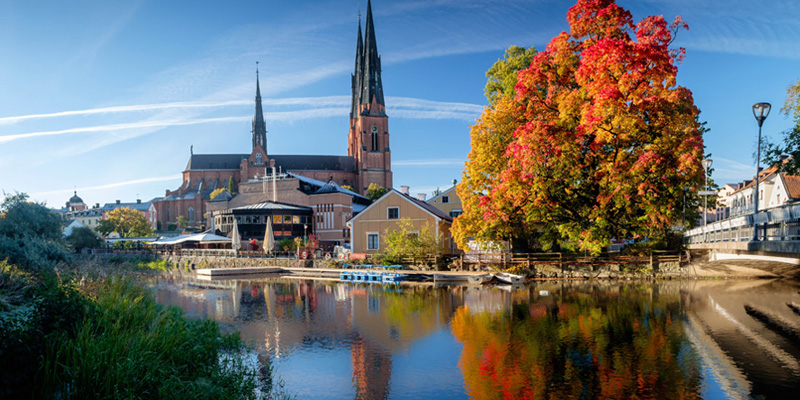Uppsala

Uppsala Cathedral is the largest and tallest cathedral is the Scandinavian countries. Work began on the church around 1270, with consecration taking place in 1435. The church towers were added later in the 15th century. It is the burial site of King Eric IX, who is the patron saint of the nation. It is also the traditional location for the coronation of new Kings of Sweden. Today the cathedral is used for services, concerts, guided tours and cultural events.
Shrouded in Norse mystery are the Royal Mounds of Gamla Uppsala. Located just north of the city, these ancient burial sites have divided the nation as to what exactly they represent. Some believed the three large mounds to be gods Thor, Odin, and Freyr, others thought them to be the burial sites of legendary kings, while some people believed them to be, well, simply natural lumps of dirt. Archaeologists have confirmed them to be burial sites, but were unable to identify who the bodies belong to. Although it is widely believed they are of royal descent.
Carl Linnaeus is the famous Swedish naturalist and explorer who was the first to frame principles for defining natural genera and species of organisms and to create a uniform system for naming them. He is widely known as the father of modern taxonomy. Across Uppsala there are many places you can visit to learn about his life and work.
The Linnaeus Gardens are Sweden’s oldest botanical gardens. The gardens are a replica of Uppsala University’s botanical garden as it would have looked during Linnaeus’ lifetime. All of the species in the garden are known to have been cultivated by the great man himself according to his own system and that makes it very special indeed. You can also visit Carl Linnaeus’s house in the city where he lived with his wife and children, today it is The Linnaeus Museum. Here you can learn everything you want to know about Carl and what life was like during his lifetime.
Travelling to Uppsala by Ferry
The Newcastle to Gothenburg (Göteborg) ferry service ended on the 30th October 2006, this service was operated by DFDS Seaways.
However, you can still reach Sweden by ferry using either our Newcastle to Amsterdam or Hull to Rotterdam routes and continue to enjoy safe and relaxing ferry travel to mainland Europe.
The Hull to Rotterdam route features overnight crossings similar to our Hull to Zeebrugge service. Your ticket will include a comfortable cabin and the ships boast a range of dining and entertainment options, including two cinema screens and a casino. You’ll then disembark in Rotterdam which offers excellent road links to Germany and then onto Denmark before reaching Sweden.
From Amsterdam, you will follow a similar route as if arriving in Rotterdam. You will take a scenic drive through Holland, into Germany and onwards to Denmark before arriving in Sweden.
Why not have a look at our Holland, Germany or Denmark Destination Guides for inspiration on places to see and do while making your road trip.